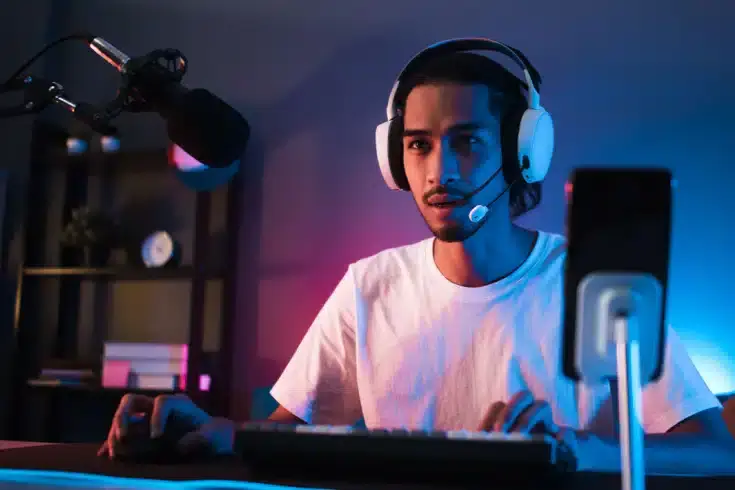Key Points of YouTube's Terms of Service to Be Aware of When Streaming Game Playthroughs

With the proliferation of YouTube and social media, the way we enjoy games has evolved. One notable change is the emergence of “Let’s Play” videos. Instead of playing games themselves, an increasing number of people are taking pleasure in watching others play and commentate through these “Let’s Play” videos. They have gained significant popularity on YouTube as a beloved genre.
When it comes to posting such “Let’s Play” videos, are there any legal issues that should be taken into consideration? This article will explain the important points to be mindful of when creating and broadcasting game commentary videos on YouTube.
Popularity of Game Streaming Videos Among Younger Audiences
According to a 2020 survey by Just Systems Corporation, 25.9% of the 1,100 male and female participants aged 17 to 69 reported having watched game streaming videos. When broken down by age group, the percentages were as follows: 55.9% for teens, 35.3% for those in their 20s, 32.5% for those in their 30s, 27.2% for those in their 40s, 8.9% for those in their 50s, and 4.8% for those in their 60s.
Furthermore, among those who watched game streaming videos and also played games themselves, 18.1% have streamed game videos. Looking at the age breakdown, the figures were 30.4% for teens, 17.5% for those in their 20s, 17.3% for those in their 30s, 12.2% for those in their 40s, 0.0% for those in their 50s, and 16.7% for those in their 60s.
(Source: Just Systems Corporation “Video & Video Advertising; Monthly Fixed-Point Survey (August 2020)”)
The survey results indicate that watching and streaming game videos has become a mainstream activity, especially among younger demographics.
Key YouTube Terms of Service to Be Aware of When Posting Game Playthrough Videos
On YouTube, there are essentially three main types of ‘terms’ that exist:
- Terms of Service
- Community Guidelines
- Various Policies, etc.
Among these, the Terms of Service are rather abstract, and the Community Guidelines and Various Policies, etc., serve to make these more concrete. It’s important to understand that even if something is not ‘legally’ illegal, it can still violate these terms and result in video removal. Therefore, when posting videos, it’s necessary to be cautious of these ‘terms.’ In this section, we will explain the YouTube Terms of Service that must be carefully considered when posting and streaming game playthrough videos.
Policy on Child Safety

Our community guidelines establish policies concerning child safety. Games that appear to be targeted at minors (under 18) or families but contain sexual themes, violence, or obscene content that is unsuitable for minors are in violation of these guidelines.
If content is intended for adults, it can be age-restricted at the time of upload. For gameplay videos, depending on the content of the game, it may be necessary to set an appropriate age restriction.
Furthermore, cyberbullying and harassment involving minors, such as:
- Content that harasses or disparages an individual
- Content that records someone without their consent
- Content that includes sexual harassment
- Content that encourages bullying or harassment of others
are also considered violations of the community guidelines.
Content that includes any of the following may also be subject to age restrictions:
- Harmful or dangerous acts that minors might imitate
- Violence, sexual acts, or death in family-oriented content, which are adult themes
- Explicit sexual expressions or offensive language inappropriate for a young audience
Related article: Explaining YouTube’s Child Policy: What Happens to Age-Restricted Content?[ja]
Games have a “Rating System.” The age-based rating system displays the appropriate age group for a game based on its content. When live streaming a game with an age classification mark, it is advisable to set an appropriate age restriction on the video as well. For more details on the rating system, please refer to the following.
Reference: Computer Entertainment Rating Organization | Rating System[ja]
Policy on Nudity and Sexual Content
Policies regarding nudity and sexual content are also established. Sexual scenes, video games, music, and other content from the real world or dramatized content may be deemed in violation of the guidelines. Posting violent, graphic, or derogatory fetish content may result in the removal of the content or the suspension of the channel.
If a game includes such content, it may be necessary to impose age restrictions. The following factors are considered when deciding whether to restrict the age for content or to remove it:
- Whether exposed or covered breasts, buttocks, and genitals are the focus of the video
- Whether the poses of the personalitys in the video are intended to arouse sexual excitement in the viewer
- Whether explicit or obscene language is used in the video
- Whether the clothing (such as lingerie) is generally accepted in public places
- Whether sexual images or sounds are blurred or indistinct
These are just a few examples, so if you think your content might violate this policy, it’s better to set an age restriction or refrain from posting the content. If your content includes pornography, your channel may also be suspended.
Reference: YouTube’s Policy on Nudity and Sexual Content
Policy on Violent and Graphic Content
Content that is violent or gruesome with the intent to shock or disgust viewers, or that encourages others to commit acts of violence, is a violation of our community guidelines. Therefore, the following types of content cannot be posted as they breach our guidelines:
- Content that incites violence against individuals or specific groups of people
- Footage, audio, or images intended to shock or disgust viewers, including traffic accidents, natural disasters, post-war scenes, post-terrorist attack scenes, street fights, assaults, sexual assaults, insults, torture, dead bodies, protest actions or riots, robberies, medical procedures, etc.
- Footage or images depicting bodily fluids such as blood or vomit with the intent to shock or disgust viewers
- Content that intentionally inflicts unnecessary pain or harm on animals
- Footage of dead bodies with severe injuries such as amputations
- Actual fights between minors at schools
Reference: YouTube’s Policy on Violent and Graphic Content
When posting gameplay videos, please ensure that the game does not contain any of the aforementioned content.
Understanding Copyright on YouTube

When it comes to gaming videos, copyright issues come into play. On this point, the YouTube Help section on “About Copyright” addresses the question “What kinds of works are protected by copyright?” by listing:
- Audiovisual works (such as TV shows, movies, and online videos)
- Sound recordings and musical compositions
- Written works (such as lectures, articles, books, and sheet music)
- Visual works (such as paintings, posters, and advertisements)
- Video games and computer software
- Dramatic works (such as plays and musicals)
These are the examples provided.
Regarding the question “Does YouTube make decisions about who owns copyright?” the answer is:
No, YouTube cannot arbitrate disputes over rights ownership. When YouTube receives a formal and valid takedown notice, it removes the content in accordance with the law. If YouTube receives a valid counter-notification, it forwards that to the person who filed the takedown notice. After that, it is up to the parties involved to address the issue, potentially through litigation.
YouTube Help | Copyright and Rights Management: What is Copyright?
When posting gaming videos, uploaders must take responsibility to ensure they do not infringe on copyrights.
Related article: What are the key points of YouTube’s Terms of Service? A lawyer explains the precautions for product introduction and review videos[ja]
Copyright and YouTube Gaming Videos
When it comes to copyright, gaming videos on YouTube have a unique aspect. If viewers find the game interesting after watching a gameplay video, it could lead to them purchasing the game. In other words, gaming videos can serve as a form of advertisement for the game.
According to a survey by Just Systems, 26.3% of viewers looked up game walkthroughs after watching a gameplay video, and 24.2% ended up purchasing the game (multiple responses were allowed; from Just Systems Co., Ltd.’s “Video & Video Advertising; Monthly Fixed-Point Survey (August 2020)”).
Especially with recent games offering more freedom in their progression than before, playing the same game does not necessarily result in the same experience. Therefore, gameplay videos do not always spoil the game, and watching them can actually increase the desire to purchase the game.
Consequently, game companies, as the rights holders, may allow the posting of gameplay videos. In such cases, uploading gameplay videos to YouTube does not violate copyright law.
For example, Capcom, which is also focusing on online games, states in their “Support” section that individuals (who do not have contracts or affiliations with companies related to video distribution, and are not part of talent agencies or productions) may post gameplay videos (including live commentary) on video sites or conduct live streams, provided they adhere to the official guidelines, and monetization of such videos is also permitted.
Square Enix has detailed guidelines and conditions for the use of copyrighted works for each title. For the “Dragon Quest” series, video distribution was previously prohibited, but the guidelines were revised in January 2021 (Reiwa 3), allowing individual video monetization. Nintendo also generally permits video distribution, provided the guidelines are followed.
Many game manufacturers fundamentally allow video distribution. While the scope of permission may vary, as long as you carefully read and comply with the guidelines, you will not be infringing on copyright.
Conclusion: Consult with Experts for Legal Checks Before Posting Videos on YouTube
As explained here, YouTube has strict standards in place, even for gaming commentary videos.
When posting gaming commentary videos, it’s not only copyright issues that require attention; even if your content doesn’t infringe copyright, violating the terms of service can still result in your video being removed.
Therefore, when uploading gaming commentary videos, it’s crucial to be mindful not only of YouTube’s terms of service but also of the guidelines set forth by the game developers.
Guidance on Measures by Our Firm
Monolith Law Office is a law firm with high expertise in IT, particularly in both the internet and legal fields. Recently, the need for legal checks, including rights to likeness, copyright, and advertising regulations, has surged among YouTubers and VTubers in managing their channels. Please refer to the article below for more details.
Areas of practice at Monolith Law Office: Japanese YouTuber & VTuber Legal Services[ja]
Category: Internet





















